NORTH MACEDONIA
Plants and Animals

Plants and Animals

Cities in NORTH MACEDONIA
| Skopje |
Plants and Animals
Plants
Due to its location between the Mediterranean and Euro-Siberian regions, North Macedonia has a very diverse flora and fauna.
North Macedonia has approximately 3,500 different plant species, ranging from alpine flowers to imported species such as kiwi, pomegranate trees and rice plants. The large number of flowers in turn attracts many species of butterflies and moths, including the hummingbird butterfly.
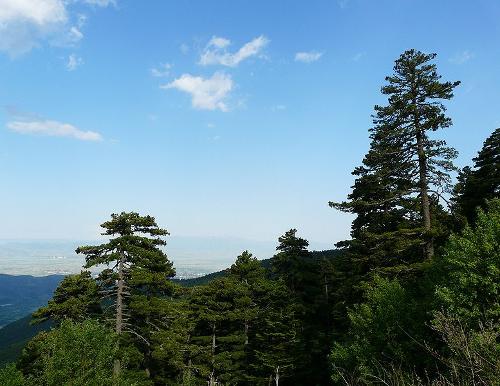 Pine trees in Pellister, Nort MacedoniaPhoto: Ksenija Putilin CC 2.0 no changes made
Pine trees in Pellister, Nort MacedoniaPhoto: Ksenija Putilin CC 2.0 no changes made
Approximately 35% of North Macedonia is covered with mainly deciduous forests. Less than 10% of the forests remain green all year round, including the Molika, Macedonian or Balkan pine. The Molika pine is most common in Pelister National Park.
Animals
There are eight protected mammal species in North Macedonia, including the brown bear. The last study from 1997 mentioned a number of 160-200, of which 70 are in Mavrovo National Park, 30 in Pelister and some bears in Galicica. Hunting of bears was banned in 1996, after which the number of bears slowly increased. Other protected animals are the lynx (about 120 specimens) and the jackal.
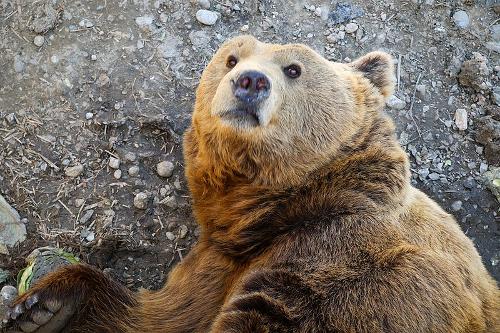 Brown Bear, North MacedoniaPhoto: 44martin 88 CC 4.0 no changes made
Brown Bear, North MacedoniaPhoto: 44martin 88 CC 4.0 no changes made
Wolves are not protected because they are a threat to farmers' sheep and cows. Every year about 350 are killed, which keeps their number at about 700. It is expected that this number will increase because the price for a shot wolf has been lowered by the government from €100 to €10.
The national parks are also home to many mammals such as martens, wild boars, chamois, deer and roe deer. Despite the fact that hunting licences are required to hunt these animals, their numbers have been reduced to only about 25% of the total population. In some areas, only 7% of the deer population is still alive.
North Macedonia has several poisonous animal species, including the 'poskog', a jumping snake, and several species of spiders. Many species of lizards can be found in the mountains and Lake Prespa is a frogs' paradise. Turtles are so common that they are almost a plague. The island of Golem Grad, located in Lake Prespa, is known as the "Snake Island" because of the many water snakes that live off the coast of the island.
Carp, bream, catfish, barbel and perch can be found in rivers and lakes. Strumica bleak, Dojran bleak and Macedonian serpentine are unique to North Macedonia, as are Dojran roach and Ohrid trout. Of the many small fish species found in Lake Ohrid, the "plašica" is the most famous. From its scales, a very special technique is used to make the famous Ohrid pearls.
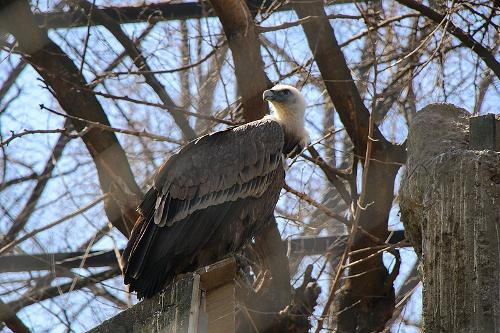 Griffon Vulture, North MacedoniaPhoto: 44martin88 CC 4.0 no changes made
Griffon Vulture, North MacedoniaPhoto: 44martin88 CC 4.0 no changes made
There are more than 330 indigenous bird species in NorthMacedonia, as well as about 100 migratory bird species. More than 50 species are protected, including vultures and eagles. A 2003 study counted 35-40 pairs of griffon vultures, 40-60 pairs of Egyptian vultures and a dozen eagles around Korab Mountain and Šar Mountain Range. Black and white storks are becoming less common, but still nest in many villages and towns.
National parks and special areas
Pelister
The Pelister National Park (since 1948) is located in the southeast of North Macedonia and covers an area of 12,500 ha. Pelister has deep valleys and peaks of more than 2000 metres, like the Pelister (2601m). Special are the two glacial lakes, known as 'Gorski Oci'.
Pelister has ten species of amphibians, fifteen species of reptiles, 91 species of birds and 35 species of mammals.
Of particular note are the Pelister river salmon (Salmo trutta peristericus) and the Pelagonia river salmon (Salmo trutta pelagonicus).
Mavrovo
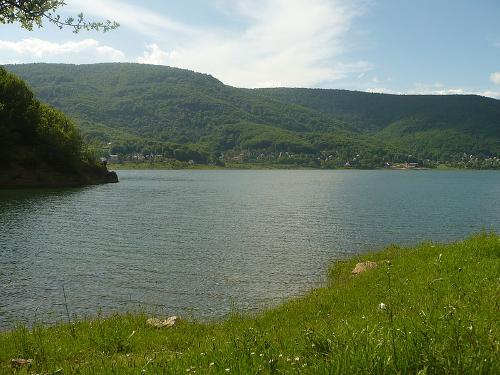 Mavrovo national park, North-MacedoniaPhoto: Darko Nikolovski CC 3.0 no changes made
Mavrovo national park, North-MacedoniaPhoto: Darko Nikolovski CC 3.0 no changes made
Mavrovo, with an area of 73,088 ha, is the largest national park in North Macedonia. The park contains the mountain peaks Korab, Desat, the south-western parts of Sar Planina, large parts of Bistra and the northern parts of Krcin.
The park is for the most part covered with beech forests. Due to the large height differences, Mavroro has a rich flora with more than 1000 species, including 38 tree species and 35 shrubs and bushes. There are also 60 endemic and rare plant species.
The animal world is also quite diverse with 40 species of birds (including birds of prey such as grey buzzard, imperial eagle, golden eagle, tawny owl, eagle owl, marsh harrier, hen harrier). Furthermore, there are 11 amphibians, 12 reptiles and 38 mammals, including brown bear, lynx, chamois and wild cat.
Galicica
Mount Galicica (22,750 ha) was declared a national park in 1958 and is located in the far south-east of North Macedonia between Lake Ohrid and Lake Prespa.
The national park is home to 12 higher plant species that only occur on Mount Galicica and the shores of the two lakes. Furthermore, there is an enormous concentration of butterfly species, more than 1600 species! There are also many reptiles and amphibians, as many as in the whole of Central Europe together.
Galicia also has 266 species of birds (84% of the total number in North Macedonia) and 51 species of mammals (62% of the total number in North Macedonia).
Ezerani
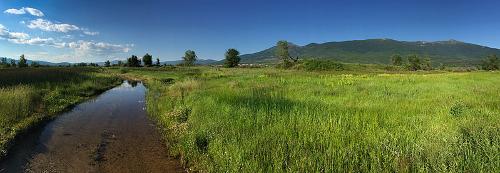 Ezerani, North-MacedoniaPhoto: Taskosmileski CC 3.0 no changes made
Ezerani, North-MacedoniaPhoto: Taskosmileski CC 3.0 no changes made
Ezerani Nature Reserve (2080 ha) is located in the northern coastal area of Lake Prespa at an altitude of 855 metres. Approximately 200 bird species live here, including 104 waterfowl. 62 species have a protected status.
Tikves
Tikves Nature Reserve (10,000 ha) is located about 30 km south of the town of Kavadarci. It is home to 23 species of birds of prey, 17 of which nest in this area. Tikves is one of the most important ornithological areas in Europe.
Lokvi-Golemo Konjari
Lokvi-Golemo Konjari Nature Reserve is the last remnant of the formerly vast Pelagonisko Blato marshland. However, a unique animal world can still be found in the remaining pools. This is the only known place in the world where the crab Chirocephalu pelagonicus can be found.
Ploce Litotelmi
The Ploce Litotelmi Nature Reserve has a number of characteristic hollows in the ground, which fill up with water after a rain or snowfall and are home to the rare crab species Tanymastix stagnalis.
Lake Ohrid
Due to its isolated location and favourable hydrographical conditions, Lake Ohrid is home to more than 200 endemic plants and animals, some of which can be considered living fossils, such as a sponge species, 27 snail species and several fish species, including the 'belvitsa', a white trout.
Canyon Matka
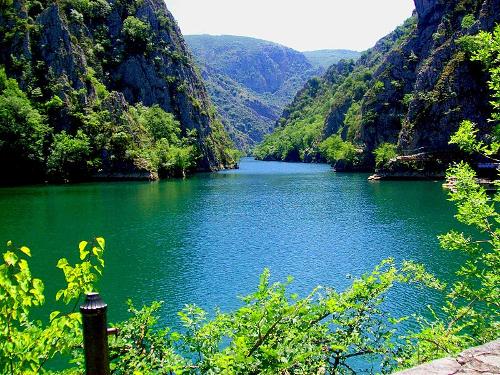 Canyon Matka, North-MacedoniaPhoto: Bijonse CC 3.0 no changes made
Canyon Matka, North-MacedoniaPhoto: Bijonse CC 3.0 no changes made
The Matka Canyon Nature Reserve (5000 ha) is located 15 km south-west of the capital Skopje. Approximately 20% of the 1000 plant species in this area are endemic or rare. Most special are the Kosanini violet (Viola kosaninii) and the Ramonda nathaliae. Recently, two more spider species and several scorpion species have been discovered. Also special are the 119 species of diurnal butterflies and 140 species of moths.
Demir Kapija-gorge
The Demir Kapija Gorge is one of the richest ornithological areas in Europe due to the presence of birds of prey such as the griffon vulture, Egyptian vulture, golden eagle, snake eagle, eagle buzzard, peregrine falcon and lesser kestrel.
Orlovo Brdo
Orlovo Brdo is one of the richest North Macedonian areas in terms of vegetation and diversity, and many endemic and rare plants and flowers, including Marianna tulip, Hedysarum macedonicum, Salvia jurisicii, Convolvulus holosericeus, Morina persica and Astragalus parnassi, occur here.
Sources
Detrez, R. / Macedonië : mensen, politiek, economie, cultuur, milieu
Koninklijk Instituut voor de Tropen
Evans, T. / Macedonia
Bradt Travel Guides
Zuid-Europa
The Reader's Digest
CIA - World Factbook
BBC - Country Profiles
Copyright: Team The World of Info